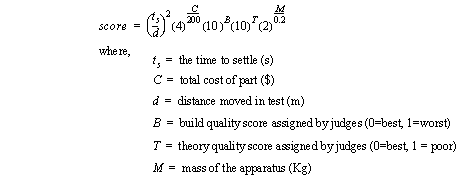OVERVIEWCranes are used to move large loads in industrial environments. To do this they normally lift a load and then move it to a new position. At the end of the motion the load is put down. If the load is swaying, the operator may have to pause before putting down the load. This delay is undesirable because it increases the total cycle time for the crane. This design project will endeavor to build a proof-of-concept prototype for an anti-sway system for a gantry crane as shown in Figure 34.1 The equipment. The crane will ride on a wooden beam constructed with 2x4 lumber (actually smaller). An electric motor will drive the cart left or right. The mass will hang below the cart. 
The system will use active compensation to move the cart between positions, and to move the cart to compensate for swaying of the suspended mass. The overall system performance will be evaluated on how quickly the crane can move the load, and then eliminate sway. Additional factors used in assessment of performance will be the mass, cost and overall design quality. 34.2.1 The Objectives and ConstraintsThe design will be mounted on 2x4 lumber and controlled through a wire harness to external electronics and power supplies. The apparatus must be easily mounted and removed without damaging the experimental setup. It will be expected to carry a 1Kg mass, suspended 40cm below the top of the 2x4. The 2x4 will be oriented so that the longer dimension is vertical. The mass will be mounted with a carriage bolt that is at least 3 inches long, with a 1/4" diameter. The arm must be able to swing freely, as it is meant to be equivalent to a cable suspending the mass. The mass will be provided with a rod that will be between 1/4" and 1/2". The mass will be a cylinder that is free to rotate to reduce dynamic effects rotation. The width of the mass will be less than or equal to the width of the 2x4. None of the cart, except for the arms, should be less than 2cm below the bottom of the 2x4. The objectives for the design are itemized below. The following equation will be used to assess the overall score for the design. - The equipment cost should be minimized. The goal of $150 or less has been specified as very important. - Mass should be minimized, the target value is 0.2Kg. - A clearly justified and supported design process. This will be judged before the competition. - The settling time, ts, to less than a +/- 0.5 inch margin around the commanded position. This time will be determined using the best ts/d for two arbitrary target motions. - The test will start with the mass stationary at one position. The gantry system must move the mass to another position once started. The total movement range will be 2 to 20 inches in 2 inch increments. 
|